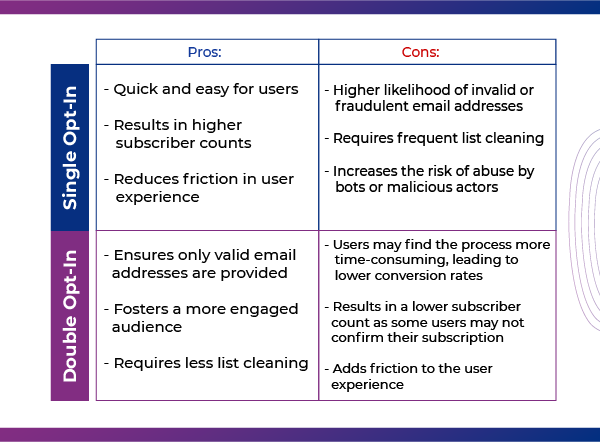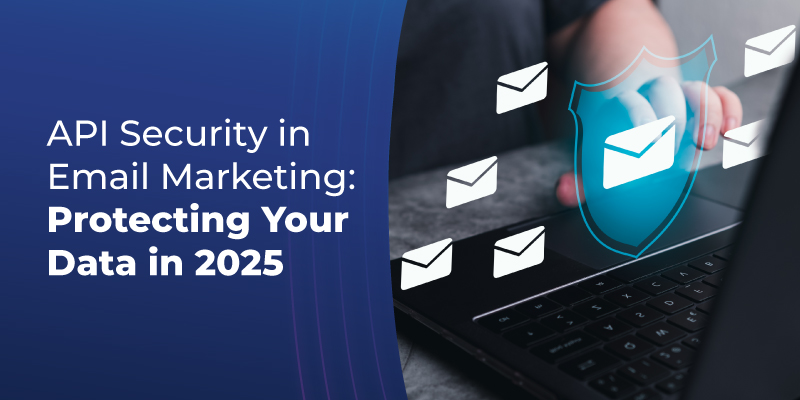Table of contents:

What is an Opt-in?
Opt-in and single opt-in are consent mechanisms used in email marketing to ensure that recipients willingly subscribe to receive promotional or informational emails from a sender.
In an opt-in process, subscribers explicitly indicate their consent to receive emails by actively signing up or checking a box on a form. This ensures that recipients have consciously chosen to receive communication from the sender, leading to higher engagement and fewer complaints about unsolicited emails.
Single opt-in, on the other hand, requires only one action from the subscriber to join a mailing list, typically filling out a form or providing an email address. While it offers a simpler signup process, it may result in higher instances of invalid or mistyped email addresses, as well as potential issues with spam complaints from recipients who did not intend to subscribe.
Both opt-in methods play a crucial role in email marketing, allowing businesses to build a loyal subscriber base while maintaining compliance with regulations and best practices in email communication.
Transitioning from single opt-in to double opt-ins may initially seem daunting if you're accustomed to the former. After all, you're effectively doubling the steps users must take before joining your email lists. This can understandably unsettle many email marketers, particularly those whose key performance indicators revolve around rapid growth. Delving into the technical intricacies of email marketing, such as deliverability and sender reputation, might seem like a luxury few can afford amidst the pursuit of expansion.
However, it's precisely why we're here today—to shed light on how prioritizing quality over quantity can ultimately save you valuable time and energy in the long haul. We firmly believe that nurturing a healthy list of engaged subscribers far outweighs the fleeting satisfaction of accumulating unvalidated email addresses daily.
So, what exactly is double opt-in?
Double opt-in entails securing explicit consent from users to receive your emails. Upon signing up, an automated confirmation email promptly arrives, containing a verification link or code that users must click or enter to confirm their subscription. This meticulous process ensures that subscribers are genuine and have willingly opted in to receive communications from you.
Now, how does this differ from other methods? When users subscribe via a registration form, you have a choice: you can either immediately start sending them newsletters—a process known as single opt-in—or you can request confirmation of their desire to receive your emails by sending a confirmation email with a verification link. It's this latter option that constitutes the double opt-in approach. The "double" aspect arises from the initial authorization during registration and the subsequent confirmation email.
Double opt-in offers several assurances
- - Validity of email addresses without typos
- - Confirmation that the email address owner is indeed the subscriber
- - Genuine interest from the new contact in receiving your communications, thus increasing the likelihood of engagement with your content
An exemplary illustration of double opt-in in action can be observed through SendClean's registration process. Following form completion, SendClean promptly sends a confirmation email, soliciting users to click a link to confirm their desire to receive price alerts. Within this email, they clearly outline the nature of their communications and provide opt-out instructions.
The double opt-in process entails several steps, in contrast to the more streamlined single opt-in.
Why Single Opt-in seems better?
- Signup form: Users fill out personal information on a website or landing page.
- Thank you page (Optional): Acknowledges user submission and advises them to check their inbox for a confirmation link.
- Confirmation email: Sent by the company containing a link to confirm subscription.
- Confirmation page: Confirm successful addition to the list post-clicking the confirmation email link.
While this multi-step process may seem daunting to some marketers, we're here to explain why it's worth the effort by going through the advantages of double opt-in.
But first, let's briefly weigh the pros and cons of single versus double opt-in:

By now, it's evident that both strategies have their merits and drawbacks. Your choice between single and double opt-in hinges on your organization's current needs and the preferences of your audience.
Double opt-in offers a plethora of benefits
1. Create self-cleaning lists:
Double opt-in mitigates the influx of incorrect or fraudulent email addresses, ensuring list accuracy and bolstering your reputation with mailbox providers.
2. Drive higher engagement:
By initiating user interaction through email verification, you lay a solid foundation for improved sender reputation and decreased likelihood of spam classification.
3. Bolster deliverability and IP reputation:
Opting for double opt-in enhances your chances of landing in users' inboxes by showcasing genuine user interest and minimizing the risk of spam traps.
4. Generate marketing qualified leads:
Double opt-in transforms mere sign-ups into warm leads, fostering a more fruitful interaction with potential customers and reducing wasted resources.
5. Future-proof from data policy changes:
While not yet a legal requirement under GDPR, double opt-in provides an extra layer of consent verification, safeguarding against potential legal ramifications and evolving privacy laws.
6. Initiate the onboarding experience:
Leveraging the double opt-in confirmation email as an opportunity to introduce your brand personality and guide users through their initial interaction sets the stage for a meaningful customer journey.
Conclusion
As you contemplate whether to adopt single or double opt-in, remember that SendClean stands ready to assist you in crafting seamless opt-in processes through our intuitive Form Builder. Regardless of your choice, prioritizing deliverability and user engagement remains paramount, ensuring sustained success in your email marketing initiatives.


